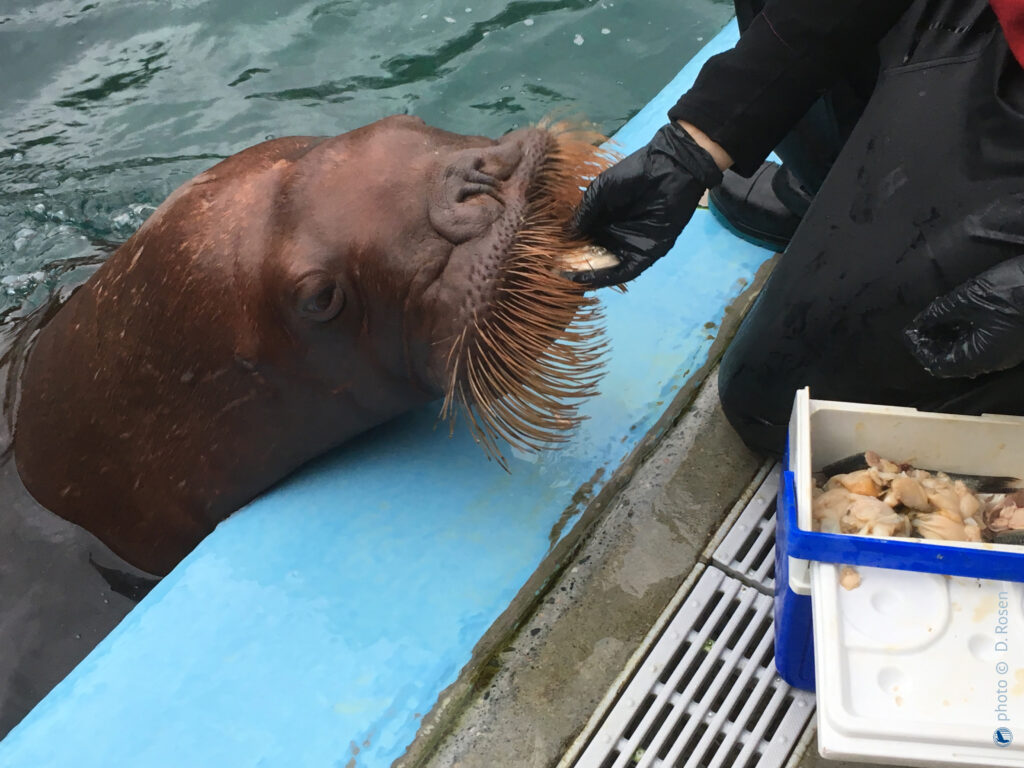New study shows loss of sea ice will require walruses to swim more and eat more to survive climate change
(photo caption) Balzak, one of two walruses that participated in the study at the Vancouver Aquarium to determine how much energy walruses spend swimming and resting in water.
Estimating how much food individual animals need, and understanding how their behaviours alter their food requirements, are necessary to predict how species will respond to climate change. In the simplest sense, an animal must obtain enough food to power all of the things it must accomplish in life—growing, staying warm, reproducing, travelling, foraging for food, etc. These individual expenses make up an animal’s total energy budget.
Scientists can build mathematical computer models to predict the cost of these individual activities, and how they might change under different environmental conditions, such as altered prey distribution, warming oceans, or deteriorating ice conditions. However, these models are only as good as the data that goes into them—and that requires detailed studies with real, live animals.
In a recent study, MMRU’s Dr. David Rosen measured energy expenditure in a pair of young walruses that were on loan to the Vancouver Aquarium from the Aquarium du Quebec. The results of the study were recently published in the journal Marine Mammal Science, and presented at the Alaska Marine Science Symposium:
While at the Vancouver Aquarium, the two walruses, Balzak and Lakina, were trained to measure two important costs—resting at the water’s surface and swimming under water. The cost of resting was measured while the walruses floated calmly in the water with their head in a floating respirometry dome, where the amount of oxygen they used could be accurately measured. To measure the cost of swimming, the walruses were trained to swim several laps of the pool—all the while remaining underwater— and then surfacing in the floating dome.
For many marine mammals, the cost of resting is much higher than for terrestrial mammals of the same size. This cost forms the foundation of many food requirement models, so inaccuracies can have a major impact on overall food estimates. However, David’s study found that the resting energy expenditure of the walruses was much lower than expected. Unfortunately for the walruses though, it turns out that any cost savings from resting are overshadowed by the cost of swimming. This is because walruses have to expend more energy while swimming than other, more streamlined, marine mammals.

Everyone who participates in research likes nothing better than a good meal at the end of a successful set of trials — even if it is just raw clams!
The aim of the study was to improve existing mathematical models of how much food walruses might need in the wild, particularly in a changing Arctic environment. More specifically, the study determined how much more energy is expended—and food required—for walruses to adapt to this changing environment. Walruses depend on hauling out onto the ice edge to rest and raise their young, which are traditionally located over top of prime clam beds. Unfortunately, a loss of ice cover due to global warming means that walruses have to spend more time in the water and travel further to reach these food sources. And, as this study demonstrates, these changes in behaviour can be very expensive.
 Publication
Publication
2021 | ||||||||||||||

|

|

 |
||||||||||||
